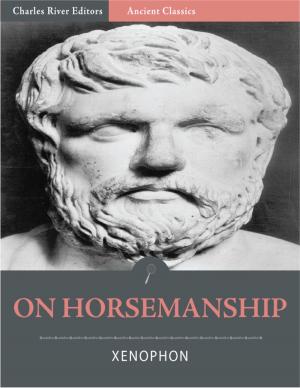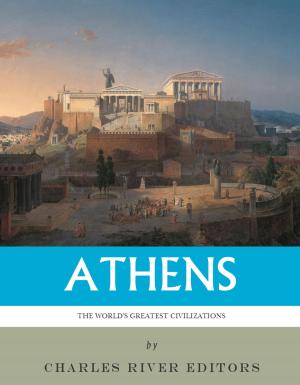The Ultimate Nero Collection
Nonfiction, History, Ancient History, Rome, Biography & Memoir, Historical| Author: | Charles River Editors, Tacitus, Plutarch, Cassius Dio, Jacob Abbott, Suetonius | ISBN: | 9781475320602 |
| Publisher: | Charles River Editors | Publication: | December 31, 2012 |
| Imprint: | Language: | English |
| Author: | Charles River Editors, Tacitus, Plutarch, Cassius Dio, Jacob Abbott, Suetonius |
| ISBN: | 9781475320602 |
| Publisher: | Charles River Editors |
| Publication: | December 31, 2012 |
| Imprint: | |
| Language: | English |
Includes:•Charles River Editors original biography of Nero•Suetonius biography of Nero from The Twelve Caesars•Books LXI-LXII in Cassius Dios Roman History, which discuss Nero•Plutarchs Life of Galba•Tacitus The Annals, Books XIII-XVI, which cover the history of Neros reign•Jacob Abbotts biographical Nero…As the strength of his vices increased, he no longer hid them, or laughed them off, but dropped all disguise, and indulged freely in greater depths of wickedness. Suetonius describing Nero, from The Twelve Caesars Throughout the annals of history, there have been few figures as reviled as Lucius Domitius Ahenobarbus, better known as Nero Claudius Caesar Drusus Germanicus, or more simply, Nero. Even today, he remains one of the Roman Empires most famous or notorious figures, a villain whose impact on popular culture is so vast that his name crops up consistently to this day in literature, film, TV and mediums as unlikely as video games and anime.Nero ranks among the very worst of the Caesars, alongside the likes of mad Caligula, slothful Commodus, and paranoid Domitian, a figure so hated that, in many ancient Christian traditions, he is literally, without hyperbole, considered the Antichrist; according to a notable Biblical scholar, the coming of the Beast and the number 666 in the Book of Revelation are references to Nero. He was the man who, famously, fiddled while Rome burned, an inveterate lecher, a murderous tyrant who showed little compunction in murdering his mother and who liked to use Christian martyrs as a source of illumination at night by burning them alive. His economic policies, according to many historians, virtually bankrupted Rome. Even his appearance, apparently, was ill-favoured. His busts show him to be fleshy-faced, with a weak chin that he attempted to disguise with a distinctly unprepossessing beard, and according to Suetionius he was also spotty, stinking, pot-bellied and thin-legged not a pretty picture. The best known accounts of Nero come from biographers like Tacitus, Cassius Dio, Suetionius and Josephus, but there are also indications that, to some extent, reports of Neros cruelty were exaggerated. Nero was popular with the common people and much of the army, and during his reign the Empire enjoyed a period of remarkable peace and stability. Many historians, including some of his ancient biographers such as Josephus suggest that there existed a strong bias against Nero. Part of this is because his successors wished to discredit him, and justify the insurrections which eventually drove him, hounded from the throne, to a lonely suicide. Much of the bias against Nero can also be attributed to the fact that he was a renowned persecutor of Christians, and since many of the historians who wrote about Nero in the years after his death were Christians themselves, it made sense for them to have a jaundiced view of their erstwhile nemesis. Because of this, some historians have suggested that Neros demeanour and reputation might not be as black as the original sources might be inclined to suggest. The Ultimate Nero Collection chronicles the life of one of Romes most notorious emperors and attempts to separate fact from fiction to analyze his reign and legacy. It includes an original biography, and famous historical writings about Nero by Cassius Dio, Plutarch, Suetonius, Tacitus, and Jacob Abbott. This collection also includes pictures and a Table of Contents.
Includes:•Charles River Editors original biography of Nero•Suetonius biography of Nero from The Twelve Caesars•Books LXI-LXII in Cassius Dios Roman History, which discuss Nero•Plutarchs Life of Galba•Tacitus The Annals, Books XIII-XVI, which cover the history of Neros reign•Jacob Abbotts biographical Nero…As the strength of his vices increased, he no longer hid them, or laughed them off, but dropped all disguise, and indulged freely in greater depths of wickedness. Suetonius describing Nero, from The Twelve Caesars Throughout the annals of history, there have been few figures as reviled as Lucius Domitius Ahenobarbus, better known as Nero Claudius Caesar Drusus Germanicus, or more simply, Nero. Even today, he remains one of the Roman Empires most famous or notorious figures, a villain whose impact on popular culture is so vast that his name crops up consistently to this day in literature, film, TV and mediums as unlikely as video games and anime.Nero ranks among the very worst of the Caesars, alongside the likes of mad Caligula, slothful Commodus, and paranoid Domitian, a figure so hated that, in many ancient Christian traditions, he is literally, without hyperbole, considered the Antichrist; according to a notable Biblical scholar, the coming of the Beast and the number 666 in the Book of Revelation are references to Nero. He was the man who, famously, fiddled while Rome burned, an inveterate lecher, a murderous tyrant who showed little compunction in murdering his mother and who liked to use Christian martyrs as a source of illumination at night by burning them alive. His economic policies, according to many historians, virtually bankrupted Rome. Even his appearance, apparently, was ill-favoured. His busts show him to be fleshy-faced, with a weak chin that he attempted to disguise with a distinctly unprepossessing beard, and according to Suetionius he was also spotty, stinking, pot-bellied and thin-legged not a pretty picture. The best known accounts of Nero come from biographers like Tacitus, Cassius Dio, Suetionius and Josephus, but there are also indications that, to some extent, reports of Neros cruelty were exaggerated. Nero was popular with the common people and much of the army, and during his reign the Empire enjoyed a period of remarkable peace and stability. Many historians, including some of his ancient biographers such as Josephus suggest that there existed a strong bias against Nero. Part of this is because his successors wished to discredit him, and justify the insurrections which eventually drove him, hounded from the throne, to a lonely suicide. Much of the bias against Nero can also be attributed to the fact that he was a renowned persecutor of Christians, and since many of the historians who wrote about Nero in the years after his death were Christians themselves, it made sense for them to have a jaundiced view of their erstwhile nemesis. Because of this, some historians have suggested that Neros demeanour and reputation might not be as black as the original sources might be inclined to suggest. The Ultimate Nero Collection chronicles the life of one of Romes most notorious emperors and attempts to separate fact from fiction to analyze his reign and legacy. It includes an original biography, and famous historical writings about Nero by Cassius Dio, Plutarch, Suetonius, Tacitus, and Jacob Abbott. This collection also includes pictures and a Table of Contents.















